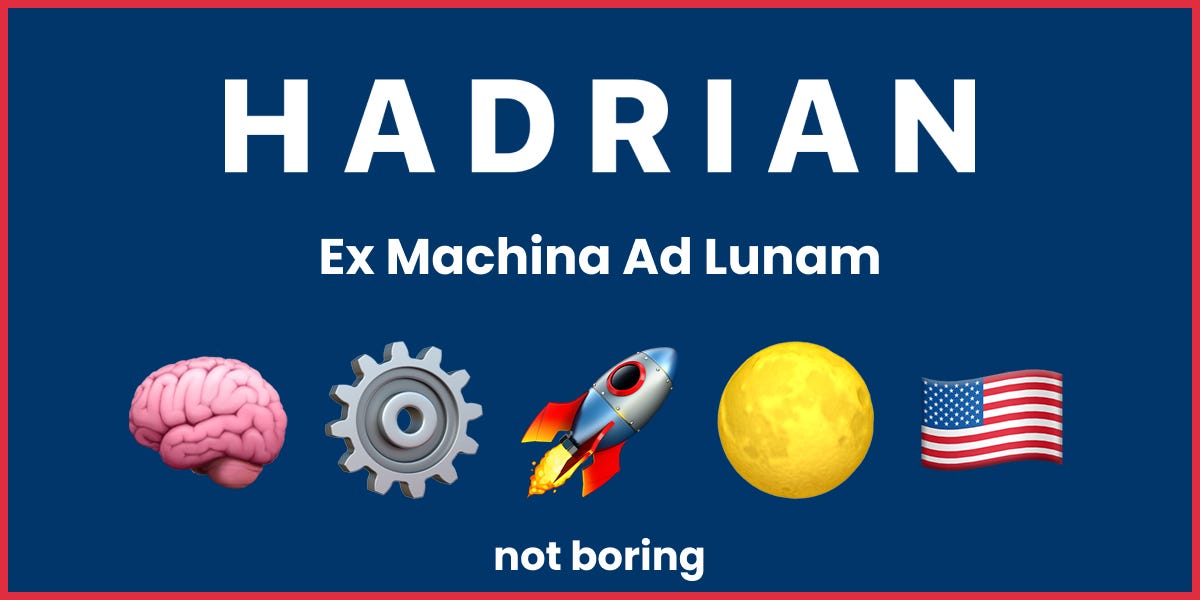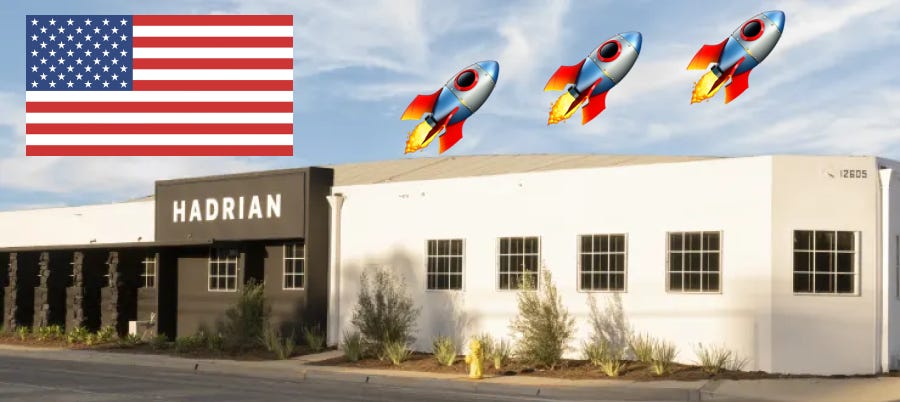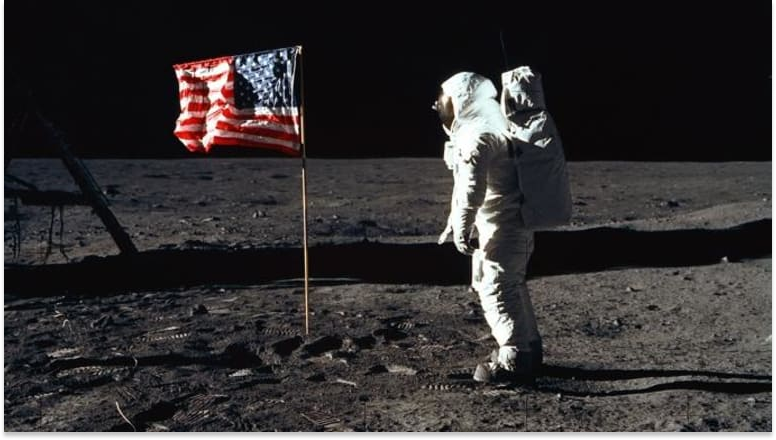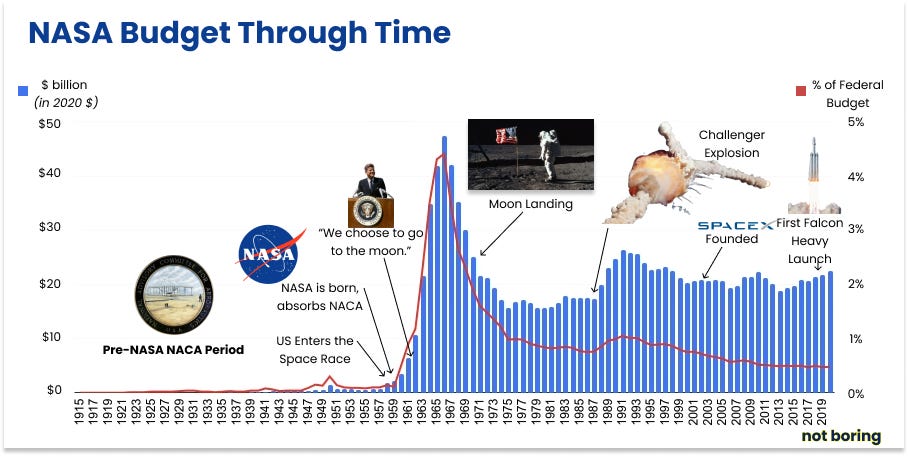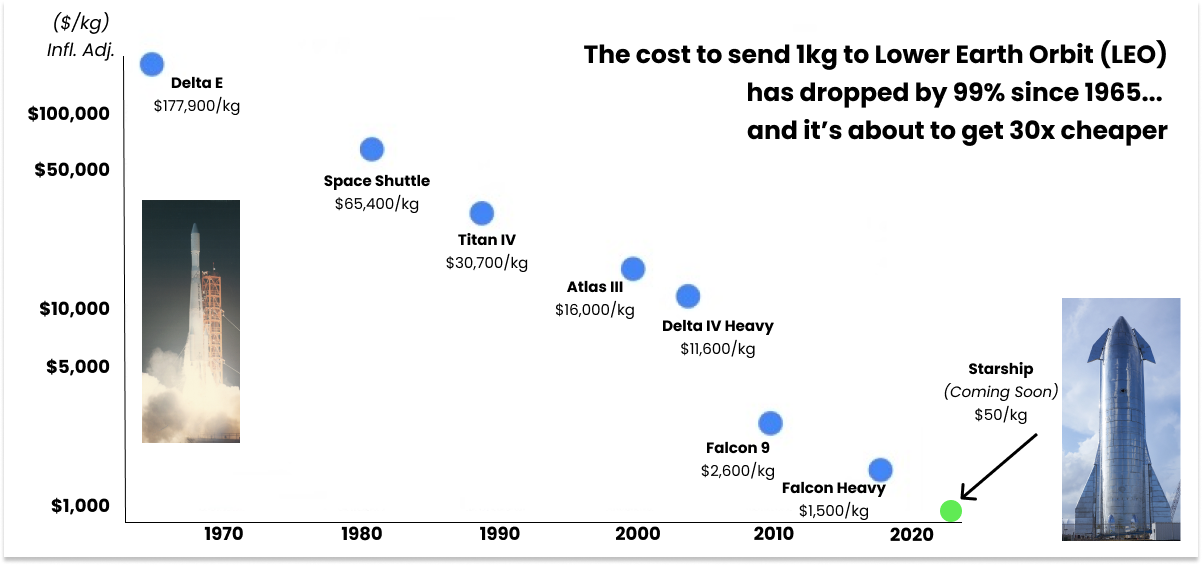Not Boring by Packy McCormick - Hadrian: Ex Machina Ad Lunam
Welcome to the 890 newly Not Boring people who have joined us since last Monday! Join 110,611 smart, curious folks by subscribing here: 🎧 To get this essay straight in your ears: listen on Spotify or Apple Podcasts Hi friends 👋, Happy Monday! If you haven’t read a Not Boring piece in a little while, read this one. Hadrian is different than the companies we normally talk about in Not Boring. While it relies heavily on software, its main focus is in the world of atoms. It uses big machines to make precision parts for rockets and satellites. It blends automation and high-skilled labor. It’s an incredible example of something we’re going to see a lot more of in the coming years (partially because Hadrian exists): startups tackling very hard, government-level problems in the physical world (and space). I’m very eager to see what happens as the worlds of bits and atoms continue to interact and co-evolve. If Hadrian succeeds in its boldest missions, Americans will build hard things with speed once again, we’ll grow a new skilled labor force by making manufacturing cool, and freedom will reign among the stars. High stakes. Note that this is a Sponsored Deep Dive (read about my selection process and conflicts here) and Not Boring Capital is a small investor in Hadrian, but neither of those facts impacted the way I’m writing this. I’ve been this excited about Hadrian since my first call with Chris after Moshe at Shrug introduced us in February (thanks Moshe!), and if anything, I’ve held back my enthusiasm. Let’s get to it. Hadrian: Ex Machina Ad Lunam(Click this link 👆 to read the whole thing online) Every startup has a lofty mission. Hadrian is the first I’ve encountered whose mission includes reversing American decline and ensuring the solar system remains free. Chris Power, Hadrian’s founder and CEO, is clear about the stakes: if the US loses military and space superiority this decade, totalitarian actors won’t just take control of the reserve currency and power on the home planet, they’ll settle the solar system. We’re in a second Space Race, one with astronomical stakes, and we’re at risk of losing because we can’t build like we used to. That’s what Hadrian wants to fix. Chris calls it the “anti-decline company.” He wants to remind people that we can still build hard things in the real world fast, like we did in the 1960s. Part of the reason Americans can’t build like we could in the ‘60s is that we’re still relying on the same advanced manufacturing supply chain we were back then, two generations (and a lot of excitement and optimism) removed. So to reverse decline, Hadrian plans to transform the legacy supply chain that powers space and defense manufacturing today into one that is faster, cheaper, more reliable, and more transparent. To do it, Chris has assembled the Avengers – world-class software engineers, machinists, CAM programmers, operations leaders, and data scientists – to transform the faltering legacy space and defense industrial base in the United States into a hyper efficient techno-industrial base. He warned them that it was going to be hard and painful, and they all signed up. The team is building precision machine factories that automate the repetitive and mindless things that can be automated and create high paying, meaningful work around the things that humans do best. At the meta level, it’s building a machine that turns tribal knowledge into software, processes, and jobs. Importantly, unlike self-driving trucks, which will automate tons of people out of jobs, machine shops literally cannot hire enough people to scale. To meet demand, there is no alternative but to simultaneously automate and train a new generation of skilled workers. If Hadrian is successful, any company that relies on precision parts – starting with space and moving into defense, medical devices, semiconductors, and energy – will be able to build 10x faster and for half the cost that they’re able to today. That means faster iteration and cheaper costs for advanced rockets, satellites, jets, and hypersonics. If that happens, US Defense will gain the manufacturing overmatch they need to maintain peace through strength on earth and in space. The US will win Space Race II. The solar system will be free. It’s a big vision. But first things first, Hadrian needs to ship its tightly-focused set of first parts – high-margin, high-precision aluminum components for space companies – on-time and on-budget. It needs to continue to hire world-class talent from the worlds of bits and atoms and get them to work together to turn tribal manufacturing knowledge into scalable software and processes. IT NEEDS TO BUILD. To help fulfill its mission, last week, Hadrian announced that it raised $90 million in two rounds: a Series A led by Brandon Reeves at Lux Capital and a Series A-Prime led by Katherine Boyle at a16z. Founders Fund and Lux led the Seed in March 2021. Hadrian is Boyle’s first investment out of the firm’s new American Dynamism practice, and it’s an appropriate first investment. It is building critical infrastructure on top of which ambitious American hard tech companies will be able to innovate with atoms the way that software companies are able to innovate with bits. Hadrian will serve as the foundation of American Dynamism. Hadrian is not the first company to try to build automated factories – in fact, it’s not the first company that Founders Fund and Lux have backed to go after the opportunity. The first one failed. Hadrian could fail too; what it’s trying to do is very hard. But the fact that both firms are back at the table with Hadrian is a testament to the size and importance of the opportunity, the timing, and to the approach that Chris and the Hadrian team are taking to tackle it. Because for everything we’ll discuss about the strategic importance of settling space and enabling military superiority, make no mistake: Hadrian has the potential to build a massive business. It’s building a Keith Rabois-style “fat startup” in a fast-growing $30 billion industry with a highly-fragmented and outdated supplier base, pursuing software-like margins, and digging moats that will make it incredibly difficult to unseat. Hadrian has the potential to be a $10 billion+ business, and one that endures for decades. It’s a prime example of a trend towards atoms-based businesses with enormous missions in categories like climate, healthcare, space, and defense – businesses that can do well by doing good, to quote the Protestants. A host of factors are intersecting at just the right time to make previously-impossible models possible and profitable, many of which we’ll discuss here and some of which we’ll save for a future piece. But while the mission and the opportunity grab headlines, Hadrian’s real magic is in the details:
Rallying people around a huge, inspiring vision and focusing on the exact right details today to get there in time is a near-impossible balancing act. Luckily for Hadrian, there are very few people in the world as good at playing on different levels at the same time as Chris is. The best leaders can take the “30,000 foot view” and zoom into the one-inch details. Both metaphorically and literally, Chris is able to take the 1,193,280,000 foot view¹ and zoom into the micron-level details². Today, we’ll cover many of them. I’ve not been this giddy researching a company in a long time, and I’ve done my best to translate what I’ve learned, how Hadrian can win, and why I think it’s important:
Everyone I spoke to on the Hadrian team acknowledged that there’s a ton of execution risk in front of them. It’s never been done before. But that’s why they’re there. They choose to work at Hadrian not because it is easy, but because it is hard. We Choose to Go to the MoonOn September 12, 1962, one year and two months before his death, President John F. Kennedy gave one of my favorite Presidential speeches in US History.  In it, JFK set a goal for the United States to send American astronauts to the moon by the end of the decade, essentially from a standing start. The Russians were far ahead of us. He acknowledged that it would be hard, but that that difficulty is precisely why we needed to do it:
Aside from the stirring rhetoric and the grandness of vision, what makes this speech so special is – and I don’t want to spoil the ending, but… – we did it. On July 20, 1969, less than seven years after the speech, Apollo 11 astronauts Neil Armstrong and Buzz Aldrin became the first humans to ever set foot on the moon. We beat the Russians. USA! USA! USA! Over the next three years, NASA’s Apollo program completed five more manned moon landings – Apollos 12, 14, 15, 16, and 17 - concluding with Apollo 17 astronauts’ Eugene Cernan and Ronald Evans’ 75 hour stay on the lunar surface in December 1972. And then… nothing. We haven’t been back since. This year marks the 50th anniversary of the last time an American set foot on the moon. In the intervening half-century since the Apollo program, NASA’s budget fell off and has slowly declined as a percentage of the Federal budget (other than a post-Challenger explosion uptick). We won the Space Race. Mission accomplished. Our eyes returned to the ground. Look up. The Race is back on. We’re in the early days of Space Race II. If you haven’t been paying attention to what’s going on in the space, it’s time to start paying attention. Things are about to get sci-fi. In the next decade, there’s a very good chance that humans will establish the first Lunar base. The first humans might set foot on Mars. Wars might be won, lost, or hopefully, deterred, based on nations’ capabilities in space. This sounds like sci-fi, but it’s very real. As the simplest example, satellites are crucial war infrastructure today; knock them out, and your enemy is blind. More extreme examples include “Rods from God,” simple tungsten rods, or even space rock, sent from space at 10x the speed of sound to hit precise targets with the force of a nuclear bomb. Space is a key battleground. Commercial activity in space will inevitably pick up, too. It already is. SpaceX has inspired a nation with everything from its manned lockdown launch to its mission to make humans a multiplanetary species, but its most immediate impact has been dramatically lowering the cost to launch things into space by making rockets reusable and increasing their payloads.
During the first Space Race, it cost $177,900 inflation-adjusted to send a kilogram to Low Earth orbit (LEO) on NASA’s Delta E. SpaceX’s Falcon Heavy has dropped the cost two orders of magnitude, to $1,500/kg. Its forthcoming Starship – the one that might take humans to Mars – is going to slash the cost once again, to around $50/kg! Elon is doing the Elon thing, lighting the match that ignites an industry, and it’s working. Today, companies can book space on a rocket for their satellites more easily than they can buy Enterprise SaaS. SpaceX has a direct impact on space by making it cheaper and easier to fly things out there, but Chris pointed out that the bigger impact might be that it has “trained a bunch of 25-year-old engineers who are now 30-year-old engineers going out to start their own companies based on what they learned at SpaceX.” Lower costs and more talent has led to an absolute explosion in the number of, and funding for, space companies: Varda, Hermeus, Astra, Astranis, ABL Space Systems, Ursa Major, Planet Labs, Epic Aerospace, LeoLabs… the list goes on and on. And then there are the companies that intend to compete with SpaceX, like Relativity and Blue Origin. There’s an excellent newsletter called Payload that you should check out if you want to keep up with space. Plus, lower launch costs don’t just mean more businesses, they mean that these businesses are able to build more experimentally and iteratively, like terrestrial startups can. That should lead to all sorts of unimaginable innovations. Think about what happens when launch costs drop. If it costs $25 million to launch your satellite into space, you better make sure that everything is perfect and that the satellite is going to last for a long time. You prioritize perfection over speed. But if it only costs $1.1 million to get your satellite up, you can test and iterate and experiment much more than you could before. When you can just reschedule and hop on the next launch if you slip on timelines, you can set more aggressive timelines. You can start to innovate much more rapidly… as long as the supply chain can support it. All of these changes, big and small, have taken place in the last five years that add up to mean a rapid liftoff in demand for spacefaring things from the private sector. And that’s before getting to the growing demand from the government for defense and exploration. “This is the perfect window to build this company,” Founders Fund’s Delian Asparouhov told me. “Supply needs were flat for sixty years and then they grew exponentially overnight, which completely overburdened the system.” And oh yeah, we’re going back to the moon. NASA is teaming up with SpaceX (and potentially one more partner) to send humans back to the moon by 2025. To understand why the current advanced manufacturing supply chain can’t handle demand, how Hadrian plans to fix it, and what the universe looks like if they succeed…Thanks to Dan for editing, to Moshe for introducing me to Chris, to Delian and Brandon for the insight, and especially to Chris and the whole Hadrian team for taking the time to talk to me and explain what they’re building and how. Not Boring Talent CollectiveOver 400 smart, curious people are looking for jobs at companies like Hadrian and in the broader web3 and startup ecosystem, and 40 growing companies have already signed up to hire them. Whether you’re looking to hire or looking for a new job, sign up here. Thanks for reading, and see you next week, Packy 1 This is the average distance from the earth to the moon. 2 Precision standards for many of the parts Hadrian will produce are measured down to the micron level (1/1000th of a millimeter). If you liked this post from Not Boring by Packy McCormick, why not share it? |
Older messages
The Current Financial Thing
Monday, March 28, 2022
Everyone's a Bear. Does that mean you have to be, too?
Ramping Up
Monday, March 21, 2022
Ramp raises $750 million at $8.1 billion in Founders Fund-led Round
TrueAccord: Unsexiness-as-a-Moat
Thursday, March 17, 2022
Bringing Debt Collection Into the New World
Fount and the Body's Magical Future
Monday, March 14, 2022
The Mad Scientist Running the Elon Musk Company Formula on Health & Performance
Flow: The Normie Blockchain
Monday, March 7, 2022
Zigging When Others Zag and Progressively Decentralizing to Win the Future
You Might Also Like
🔮 $320B investments by Meta, Amazon, & Google!
Friday, February 14, 2025
🧠 AI is exploding already!
✍🏼 Why founders are using Playbookz
Friday, February 14, 2025
Busy founders are using Playbookz build ultra profitable personal brands
Is AI going to help or hurt your SEO?
Friday, February 14, 2025
Everyone is talking about how AI is changing SEO, but what you should be asking is how you can change your SEO game with AI. Join me and my team on Tuesday, February 18, for a live webinar where we
Our marketing playbook revealed
Friday, February 14, 2025
Today's Guide to the Marketing Jungle from Social Media Examiner... Presented by social-media-marketing-world-logo It's National Cribbage Day, Reader... Don't get skunked! In today's
Connect one-on-one with programmatic marketing leaders
Friday, February 14, 2025
Enhanced networking at Digiday events
Outsmart Your SaaS Competitors with These SEO Strategies 🚀
Friday, February 14, 2025
SEO Tip #76
Temu and Shein's Dominance Is Over [Roundup]
Friday, February 14, 2025
Hey Reader, Is the removal of the de minimis threshold a win for e-commerce sellers? With Chinese marketplaces like Shein and Temu taking advantage of this threshold, does the removal mean consumers
"Agencies are dying."
Friday, February 14, 2025
What this means for your agency and how to navigate the shift ͏ ͏ ͏ ͏ ͏ ͏ ͏ ͏ ͏ ͏ ͏ ͏ ͏ ͏ ͏ ͏ ͏ ͏ ͏ ͏ ͏ ͏ ͏ ͏ ͏ ͏ ͏ ͏ ͏ ͏ ͏ ͏ ͏ ͏ ͏ ͏ ͏ ͏ ͏ ͏ ͏ ͏ ͏ ͏ ͏ ͏
Is GEO replacing SEO?
Friday, February 14, 2025
Generative Engine Optimization (GEO) is here, and Search Engine Optimization (SEO) is under threat. But what is GEO? What does it involve? And what is in store for businesses that rely on SEO to drive
🌁#87: Why DeepResearch Should Be Your New Hire
Friday, February 14, 2025
– this new agent from OpenAI is mind blowing and – I can't believe I say that – worth $200/month
